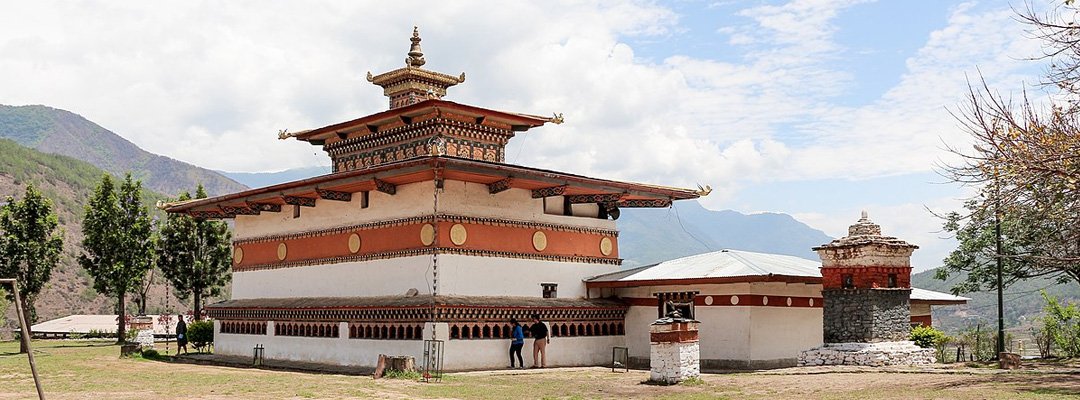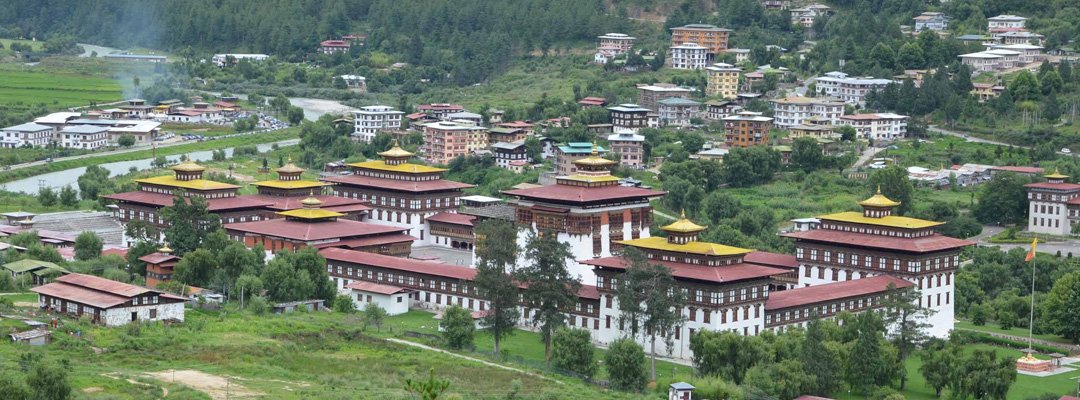Amazing Bhutan
The tiny Buddhist Kingdom of Bhutan awaits, nestled high in the Himalayas its isolation from the world has cultivated a culture rich in traditions, religion and a benevolent monarchy. The dramatic landscapes, from snow capped peaks and deeply forested slopes to raging, boulder strewn rivers, sit largely undisturbed as the endeared environmental initiatives and religious beliefs leave the Kingdom pristine and a jewel of nature. The Amankora program takes you into this ancient Kingdom for an adventure into the hearts and lands of charming farmers, fascinating weavers, enchanting monks and charismatic leaders.

On a clear day, the flight to Paro is one of the most spectacular of all mountain flights. Whether flying along the Himalayan range from Kathmandu or over the foothills from Kolkata, the journey offers you wonderful views of the Himalayas and an exciting descent into the kingdom
Your representative will greet you at Paro airport. After completion of arrival formalities, you will be transferred to your hotel.
Afternoon free or program may be arranged, according to choice. In the evening, take a stroll along the town’s main street. Overnight at the hotel in Paro.

Dramatic drives over the high mountain pass of Dochu La and on to the Phobjika Valley. Sights on the way include one of Bhutan’s first fortress monasteries, the 17th century Simtokha Dzong. The journey continues over the 3,050m mountain pass where on a clear day, towering Himalayan peaks are clearly visible.
Upon entering the Punakha you will visit Sangchhen Dorji Lhuendrup Lhakhang perched on a ridge amid pine trees and overlooking valleys of Punakha and Wangduephodrang, gleams the magnificent structures of Sangchhen Dorji Lhuendrup Lhakhang (Temple). The temple houses a 14-foot main bronze statue of Avalokiteshvara (Chenrigzig chagtong chentong). Other statues include those of Guru Padmasambawa, Gautama Buddha, Zhabdrung Ngawang Namgyel, Tsela Namsum, the 21 Taras and Tsepamay (Buddha of longevity). The Avalokiteshvara statue, one of the biggest in the country, was the handiwork of entirely local Bhutanese artisans.
The temple complex also houses a permanent higher learning and meditation centre for nuns where, apart from religious trainings, it provides life skill training such as tailoring, embroidery, statue making and thangka painting.
Later afternoon stop to stretch your legs for a short walk through the valley floor to the Chimi Lhakhang, the auspicious fertility monastery built by the “Divine Madman” in 1499. Overnight at hotel in Punakha.

Your day in Punakha Valley begins with a hike up thru fields of chillies, cabbages and rice along the banks of the Mo Chhu to the upper end of the valley to the Khamsum Yuelley Namgyal Chorten, a stunning monument recently built by the Queens and consecrated in 1999. Returning down thru the valley you will have plenty of time to take in the impressive Punakha Dzong, home to the remains of Bhutan’s first ruler, Shabdrung Nawang Namgyal, and the winter residence of the monastic order’s leader and his entourage of monks. Later a picnic lunch will be served on the banks of the Punak Chhu at a vantage point of the stunning Dzong and confluence of the Mo Chhu and Pho Chhu. Following lunch a quick drive will take you to the village of Talo where you will stop to walk the stunning, quiet grounds of the village temple.
Overnight at hotel in Punakha.

An early departure for a dramatic drive to the Phobjika Valley – The descent down thru the Punakha Valley along the Kingdom’s only east-west highway continues on through the scenic village of Wangdi. Carrying on the highway follows the scenic Dang Chhu before climbing thru forests of bamboo and oak, and just before crossing the Pele La pass, a small side road splinters off to the hidden Phobjika Valley. Upon arrival you will have time to visit the striking Gangtey Goemba, sitting at the head of the valley, and perhaps strolling through the quaint Gangtey village or hike amongst the beautiful village.
Overnight at hotel in Gangtey

The drive is on the same highway you have been and is around 5 hours. After descending back down from Dochu La, you will follow your way back up the dramatic Wang Chu.
Upon arrival, check-in at the hotel. In the afternoon, you will pay visit to the National Memorial Chorten. The building of this landmark was envisaged by the third king, His Majesty Jigme Dorji Wangchuck, as a monument to world peace and prosperity. Completed in 1974 after his untimely death, it is both a memorial to the Late King (“the father of modern Bhutan”) and a monument to world peace. The paintings and statues inside the monument provide a deep insight into the Buddhist philosophy. Later, take a stroll along the town’s main street.
Rest of the afternoon free for strolling around Thimphu town.
Overnight at the hotel in Thimphu

The capital town of Bhutan and the center of government, religion and commerce, Thimphu is a lively place, an interesting combination of tradition and modernity. Home to civil servants, expatriates and the monk body, Thimphu maintains a strong national character in its architectural style.
After breakfast, you will drive towards Cheri monastery which is 13-15 km outside of Thimphu. You will drive along the main highway. Along the way, you will pass by the Queen Mother’s Palace and a small local village.
This monastery was built by Shabdrung Ngawang Namgyal in 1620. A silver chorten inside the monastery holds the ashes of the Shabdrung’s father. This trek trail starts by crossing a lovely bridge that spans the Thimphu River, and then climbs steeply to the monastery. The journey takes about an hour.
Afternoon visit Weekend Market: Most of the Thimphu’s population and many valley dwellers converge on the bustling weekend market, held down by the river. A wide range of foodstuffs and local arts and crafts are sold at the market, which runs from Friday afternoon to Sunday. A visit to the market provides great photo opportunities, as well as the chance to mingle with local people and perhaps buy souvenirs.
Followed by visit to Thangtong Dewachen Nunnery; the only nunnery in the Capital it is popularly known as Zilukha Anim Dratshang. Located few minutes’ drive from the town. It was built in 1976 by the 16th emanation of Thangtong Gyalpo, Drubthob Rikey Jadrel. You may interact with some 60 nuns or so that has devoted their life to spirituality and Buddhism.
If In the evening if time permits, drive to Kuenselphodrang to view the world’s largest and the tallest statue of Lord Buddha. The 169-feet bronze statue of Buddha Dordenma symbolizes indestructibility, and seated on a vajra throne, overlooking the capital city.
Overnight at hotel in Thimphu.

Drive to Paro. The drive is on the same highway you have been and is around 1 hour. We will stop at Wangsisina farm house for lunch to experience not just traditional Bhutanese food in authentic surrounding
Upon arrival to Paro you will visit National Museum. The museum collection includes ancient Bhutanese art and artefacts, weapons, coins, stamps and a small natural history collection followed by visit to Rinpung Dzong – Built in 1646 by Shabdrung Ngawang Namgyal , the first spiritual and temporal ruler of Bhutan, the Dzong houses the monastic body of Paro, the office of the Dzongda (district administrative head) and Thrimpon (judge) of Paro district.
Afternoon visit KyichuLhakhang – It is one of the oldest and most sacred shrines of the Kingdom dating back to 7th century (the other is Jambey Lhakahng in Bumthang). The lhakhang complex is composed of two temples. The first temple was built by Tibetan King, Songtsen Gampo in the 7th century and in 1968, H.M. Ashi Kesang, the Queen Mother of Bhutan, built the second temple in original pattern.
In the evening stroll Main Street for some interesting Himalayan artefacts or textiles. Overnight at hotel in Paro.

Enjoy the day with a great hike. Every walking guest find this trip little challenging because of the elevation gain and the dramatic walks through the gorge. We start the day with a 30 minutes drive to the starting point of Taktsang hike. Start the uphill walk slowly so that you can get use to with the altitude, which is 600-700 meters above the valley floor. In an hour’s time we should get to the cafeteria, which is like 3 kms. Have refreshment here and enjoy a scenic hike for another 3 kms uphill till the temple. We walk uphill till for half the journey and then fairly easy till the last view point. From here we will walk down the gorge and up till the temple. Visit the temple and come back to the cafeteria for lunch. This will take around 2-3 hours and if you think you need a horse ride up the hill, please let your guide know well in advance
Later afternoon drive to the ruins of Drukgyel Dzong, about 18 km. up the valley. From this fortress, built in 1647 by the Zhabdrung, Bhutanese repelled several invading Tibetan armies during the 17th century. In the evening stroll through the town an interesting combination of tradition and modernity.
Overnight at the hotel in Paro

Early morning drive to Paro international airport for onward flight.


